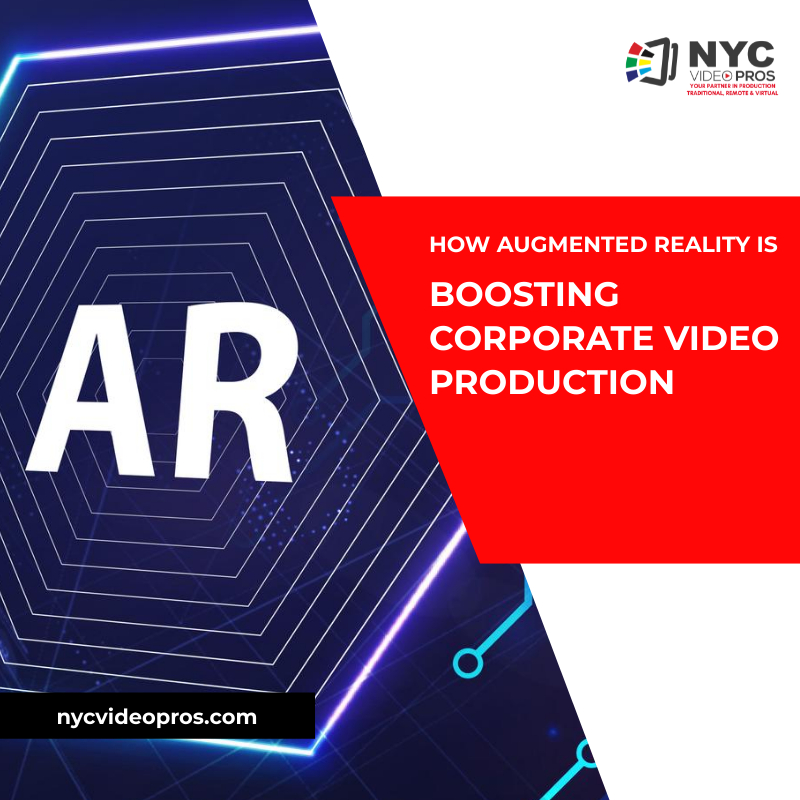The virtual arena has already brought with it virtually limitless opportunities for illustrative content, but what could be the role augmented reality play here and how can this new field be used to improve corporate video production?
Augmented Reality (AR), like Virtual Reality (VR), is a “digitally modified view of the real world.” Unlike VR, AR doesn’t entail shutting yourself off entirely from the real world but instead lets you experience an altered version of it. This is achieved by using readily available, everyday objects or surroundings, for example, a smartphone, tablet, or laptop.

What AR does is overlay a computer-generated image on a real, physical object. This “smart” technology combines, for example, sound, 3D graphics and GPS location data to explain processes more clearly or entertain users.
Augmented reality has already emerged as a major technology trend, with leading tech companies like Facebook, Google and Apple investing heavily in this technology, and the effects are already being felt in various sectors. The most obvious example here, of course, is the gaming industry. AR game Pokemon Go, for instance, saw users literally running through their cities to catch little Pokemon creatures, while the game also made considerable revenue for Nintendo, which became the biggest mobile gaming company overnight.
Examples of AR Implementation in Businesses
But AR’s omnipresence is becoming increasingly apparent in other industries, too, not least in the lucrative world of marketing. There is a plethora of examples here: Amazon lets you view products in 3D, IKEA lets you see how furniture would look in your living room, and Mercedes-Benz lets you experience what it’s like to drive one of their cars. Back in 2012, IKEA even created a live app, where you could place the IKEA catalog on your kitchen table, and point your smartphone camera at certain pages on the catalog. Then, augmented reality would let you see how a particular piece of furniture would look on the kitchen table.
Augmented Reality in Corporate Video Production
For companies, this technology is valuable, as it gives them a direct channel to their customers, and great opportunities to impress and, ultimately, sell. But augmented reality also has even better applications when it comes to corporate video production. This concept allows businesses to, quite literally, put themselves in the minds of their customers. It allowed them to, for example, create a virtual showroom.
Virtual Tours and Virtual Showroom
Let’s look at an example of how this could work. A tech company gets a commission to redesign the sales process for a new, complicated product. They decide the best thing to do is create a virtual tour of the virtual showroom for their clients. Using various images, graphics, and videos, they create a digital replica, supplementing it with sounds and animations, in order to make it as immersive as possible. They then give this to their clients, who can then view it via their digital devices, or even as part of a client presentation. The clients are not only impressed by the quality of the presentation, but also by the fact that the company has gone the extra mile to create something completely bespoke for them and their needs, which can only be good for business.
Interactive Video
Another example is using AR in an interactive video. Imagine a company wants to show its products off, and, instead of using a conventional video, they create an interactive video. In this, viewers literally get to touch the product, turning it around and zooming in and out, allowing them to see every detail. This AR technology can also allow viewers to navigate their way through a video, for example by zooming in and out on particular aspects or searching for specific words and phrases, helping them find the information they need.
AR technology is slowly but surely changing the way businesses look, creating new ways to forge closer ties with customers. This can make businesses stand out from the competition, while also making them seem more trustworthy and forward-thinking. This, in turn, can lead to improved customer retention, and, in turn, subsequently increased sales.
Training Videos with AR Feature
AR technology can also be utilized in training videos, where trainees can practice operating complicated machinery, for example. This can help them get to grips with things in a risk-free environment, without the fear of damaging expensive machinery. This could also be useful for health and safety videos, as they could help workers identify potential hazards. And, if, for example, there was a fire, AR technology could overlay important information, such as escape routes, right on workers’ fields of view.
So augmented reality is considerably useful when it comes to corporate video production. Thanks to the technology’s versatility, it can be used in a virtually limitless number of ways, all of which allow businesses to forge closer ties with their customers and improve their corporate image in the process.

